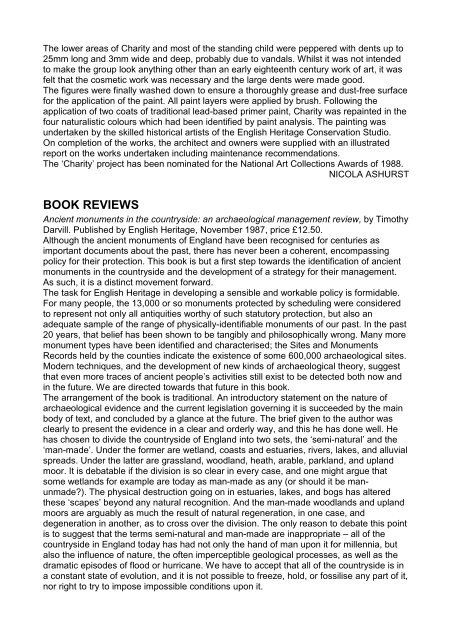Conservation Bulletin 4 | PDF - English Heritage
Conservation Bulletin 4 | PDF - English Heritage
Conservation Bulletin 4 | PDF - English Heritage
Create successful ePaper yourself
Turn your PDF publications into a flip-book with our unique Google optimized e-Paper software.
The lower areas of Charity and most of the standing child were peppered with dents up to<br />
25mm long and 3mm wide and deep, probably due to vandals. Whilst it was not intended<br />
to make the group look anything other than an early eighteenth century work of art, it was<br />
felt that the cosmetic work was necessary and the large dents were made good.<br />
The figures were finally washed down to ensure a thoroughly grease and dust-free surface<br />
for the application of the paint. All paint layers were applied by brush. Following the<br />
application of two coats of traditional lead-based primer paint, Charity was repainted in the<br />
four naturalistic colours which had been identified by paint analysis. The painting was<br />
undertaken by the skilled historical artists of the <strong>English</strong> <strong>Heritage</strong> <strong>Conservation</strong> Studio.<br />
On completion of the works, the architect and owners were supplied with an illustrated<br />
report on the works undertaken including maintenance recommendations.<br />
The ‘Charity’ project has been nominated for the National Art Collections Awards of 1988.<br />
NICOLA ASHURST<br />
BOOK REVIEWS<br />
Ancient monuments in the countryside: an archaeological management review, by Timothy<br />
Darvill. Published by <strong>English</strong> <strong>Heritage</strong>, November 1987, price £12.50.<br />
Although the ancient monuments of England have been recognised for centuries as<br />
important documents about the past, there has never been a coherent, encompassing<br />
policy for their protection. This book is but a first step towards the identification of ancient<br />
monuments in the countryside and the development of a strategy for their management.<br />
As such, it is a distinct movement forward.<br />
The task for <strong>English</strong> <strong>Heritage</strong> in developing a sensible and workable policy is formidable.<br />
For many people, the 13,000 or so monuments protected by scheduling were considered<br />
to represent not only all antiquities worthy of such statutory protection, but also an<br />
adequate sample of the range of physically-identifiable monuments of our past. In the past<br />
20 years, that belief has been shown to be tangibly and philosophically wrong. Many more<br />
monument types have been identified and characterised; the Sites and Monuments<br />
Records held by the counties indicate the existence of some 600,000 archaeological sites.<br />
Modern techniques, and the development of new kinds of archaeological theory, suggest<br />
that even more traces of ancient people’s activities still exist to be detected both now and<br />
in the future. We are directed towards that future in this book.<br />
The arrangement of the book is traditional. An introductory statement on the nature of<br />
archaeological evidence and the current legislation governing it is succeeded by the main<br />
body of text, and concluded by a glance at the future. The brief given to the author was<br />
clearly to present the evidence in a clear and orderly way, and this he has done well. He<br />
has chosen to divide the countryside of England into two sets, the ‘semi-natural’ and the<br />
‘man-made’. Under the former are wetland, coasts and estuaries, rivers, lakes, and alluvial<br />
spreads. Under the latter are grassland, woodland, heath, arable, parkland, and upland<br />
moor. It is debatable if the division is so clear in every case, and one might argue that<br />
some wetlands for example are today as man-made as any (or should it be manunmade?).<br />
The physical destruction going on in estuaries, lakes, and bogs has altered<br />
these ‘scapes’ beyond any natural recognition. And the man-made woodlands and upland<br />
moors are arguably as much the result of natural regeneration, in one case, and<br />
degeneration in another, as to cross over the division. The only reason to debate this point<br />
is to suggest that the terms semi-natural and man-made are inappropriate – all of the<br />
countryside in England today has had not only the hand of man upon it for millennia, but<br />
also the influence of nature, the often imperceptible geological processes, as well as the<br />
dramatic episodes of flood or hurricane. We have to accept that all of the countryside is in<br />
a constant state of evolution, and it is not possible to freeze, hold, or fossilise any part of it,<br />
nor right to try to impose impossible conditions upon it.
















